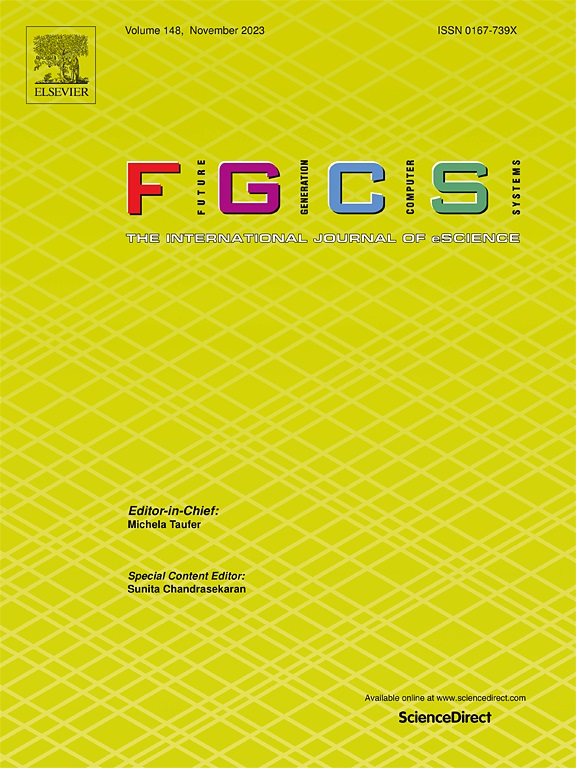ESDI: An efficient and secure data integrity verification scheme for indoor navigation
IF 6.2
2区 计算机科学
Q1 COMPUTER SCIENCE, THEORY & METHODS
Future Generation Computer Systems-The International Journal of Escience
Pub Date : 2025-02-19
DOI:10.1016/j.future.2025.107759
引用次数: 0
Abstract
Currently, indoor navigation software is typically embedded in smartphones as mobile applications. These apps enable users to access cloud-based data while retrieving indoor navigation information. However, cloud data faces risks of tampering and deletion, necessitating verification of its integrity by users. While smartphones possess certain computational capabilities, prolonged execution of computationally intensive tasks can lead to rapid battery depletion. Additionally, excessive storage demands may prompt users to frequently close or even uninstall the apps to free up memory. This paper presents a blockchain-based data integrity verification scheme tailored for indoor navigation. To address storage overhead, we introduce a user-frequency-based selection technique that designates certain blockchain nodes as light nodes. We further propose a Merkle Hash Tree-based proof extraction method to facilitate efficient proof transfer between different types of nodes. Our approach incorporates an efficient Zhang-Safavi-Susilo (ZSS) signature-based data auditing protocol. By leveraging a data label placement mechanism during signature generation, our scheme supports tamper-proof batch verification, significantly reducing computational overhead. To enable dynamic data updates, we design a novel dynamic data structure, the Red-Black Hash Table, which enhances efficiency in handling updates. Through rigorous security analysis, we demonstrate that our scheme effectively defends against forgery, replay, and replacement attacks. We implemented and simulated our solution on smartphones and indoor navigation apps, conducting experimental evaluations using indoor positioning data. We take audit initialization overhead, audit verification computation overhead, evidence storage overhead, consensus computation overhead, etc. as important experimental indicators. Performance results indicate that our scheme, Efficient and Secure Data Integrity (ESDI), improves auditing efficiency by approximately 54% on average compared to existing approaches.

ESDI:一种高效、安全的室内导航数据完整性验证方案
目前,室内导航软件通常作为移动应用程序嵌入智能手机。这些应用程序使用户能够在检索室内导航信息的同时访问基于云的数据。然而,云数据面临被篡改和删除的风险,需要用户对其完整性进行验证。虽然智能手机具有一定的计算能力,但长时间执行计算密集型任务可能会导致电池迅速耗尽。此外,过多的存储需求可能会促使用户频繁关闭甚至卸载应用程序以释放内存。本文提出了一种针对室内导航的基于区块链的数据完整性验证方案。为了解决存储开销问题,我们引入了一种基于用户频率的选择技术,该技术将某些区块链节点指定为轻节点。我们进一步提出了一种基于Merkle哈希树的证明提取方法,以促进不同类型节点之间的有效证明转移。我们的方法结合了一个高效的基于zhangsafavi - susilo (ZSS)签名的数据审计协议。通过在签名生成过程中利用数据标签放置机制,我们的方案支持防篡改批验证,显著降低了计算开销。为了实现动态数据更新,我们设计了一种新的动态数据结构——红黑哈希表,它提高了处理更新的效率。通过严格的安全分析,我们证明了我们的方案可以有效地防御伪造、重放和替换攻击。我们在智能手机和室内导航应用程序上实施和模拟了我们的解决方案,并使用室内定位数据进行了实验评估。我们将审计初始化开销、审计验证计算开销、证据存储开销、共识计算开销等作为重要的实验指标。性能结果表明,与现有方法相比,我们的方案,高效和安全数据完整性(ESDI),将审计效率平均提高了约54%。
本文章由计算机程序翻译,如有差异,请以英文原文为准。
求助全文
约1分钟内获得全文
求助全文
来源期刊
CiteScore
19.90
自引率
2.70%
发文量
376
审稿时长
10.6 months
期刊介绍:
Computing infrastructures and systems are constantly evolving, resulting in increasingly complex and collaborative scientific applications. To cope with these advancements, there is a growing need for collaborative tools that can effectively map, control, and execute these applications.
Furthermore, with the explosion of Big Data, there is a requirement for innovative methods and infrastructures to collect, analyze, and derive meaningful insights from the vast amount of data generated. This necessitates the integration of computational and storage capabilities, databases, sensors, and human collaboration.
Future Generation Computer Systems aims to pioneer advancements in distributed systems, collaborative environments, high-performance computing, and Big Data analytics. It strives to stay at the forefront of developments in grids, clouds, and the Internet of Things (IoT) to effectively address the challenges posed by these wide-area, fully distributed sensing and computing systems.

 求助内容:
求助内容: 应助结果提醒方式:
应助结果提醒方式:


